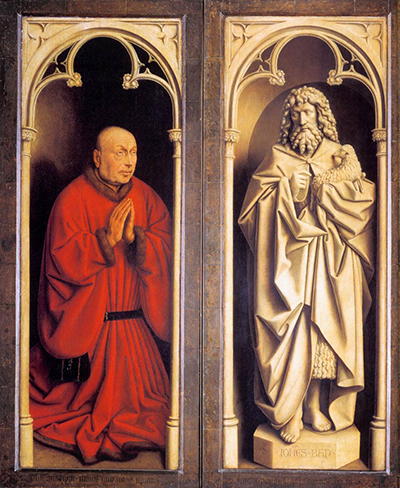This is a panel from the Ghent Altarpiece, which is visible when the triptych is in its closed position. Large parts of this project have artworks on both sides of the panel, so that different items can be seen depending on whether it is open or not.
There are two figures to be found in this part of the altarpiece, one from the real world, and one from religious scripture. It was entirely normal to mix the two together during the periods of the Renaissance and also later in the Baroque. In most cases where masters were involved in the creation of these artworks, it would be those commissioning the pieces who might request their own inclusion in the work, often alongside religious figures which was intended as a means to portraying themselves as godly. In the example of the Ghent Altarpiece, the donor, Jodocus Vyd, was not as self centered as this and was clearly happy with a more subtle inclusion within one of the side panels. He is placed next to St John the Baptist in two narrow panels which sit on the outer sides.
Both paintings were carefully sized in order to fit into the overall presentation, and as such they are both around a metre and a half in height, and around half a metre in width. The triptych can be found on display in the Cathedral of St Bavo, Ghent. The overall altarpiece features in the bottom sections the combination of donors with their respective patron saints. Vyd (deputy burgomaster of Ghent) is included, as well as his wife. At this time in artistic development, Van Eyck was impressing many with the realistic nature of his portraits that perhaps looked more realistic than what had gone before. This was an artist who also helped to push oil techniques onwards towards the different ideas that we have found in more recent centuries as it was a fairly new material within the art world at that time.
The Ghent Altarpiece would become one of the major highlights of this artist's career, featuring extraordinary detail in each and every panel to produce an overall experience that is hard to match within any period of European art history. It is easy to understand how van Eyck would become that rare creature, an artist who achieved fame and respect within his own lifetime. His work took Gothic styles and developed them onwards in a way which was both evolutionary but also impressed more conservative voices as well. It is a hard balance to achieve, and few others have managed to do it. There are also elements within the various panels which then appear again across his separate artworks, including his portraits. An additional note to bear in mind is how he would paint architectural features which was a trademark of his paintings and also something relatively new to the medium of painting at that time.




